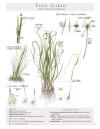
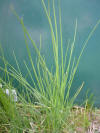
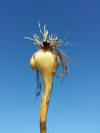


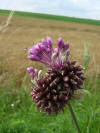
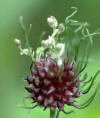


WILD
FOODIES' HOME PAGE
PLANT PROFILE LIST

NAME: Wild Garlic
SPECIES / FAMILY: Allium Vineale / Amaryllidaceae
OTHER COMMON NAME(S): onion grass, crow garlic, stag's garlic
CONDITIONS: sun
|
PARTS: |
EDIBLE |
TASTE |
RAW/COOK |
SEASON |
|
All |
|
|
|
|
|
Shoots |
|
|
|
|
|
Leaves |
|
onion/garlic |
RAW/COOK |
All year |
|
Buds/Flowers |
|
onion/garlic |
RAW/COOK |
Spring-Summer |
|
Fruits |
|
|
|
|
|
Roots/Bulbs |
|
onion/garlic |
RAW/COOK |
Spring best |
|
Seeds |
|
|||
|
Nuts |
|
|
|
|
|
Pods |
|
|
|
|
|
Stalk |
|
|
|
|
|
Bark |
|
|
|
|
PORTION: small, herb
COMMENT: Think "wild chives"! The whole plant is edible, including various stages of flower and seed production. Wild Garlic is most often called "onion grass" because it looks a lot like thin-bladed grass. Although it grows all year round, you notice it mostly in the winter time because it grows in tufts sticking up above most lawns. To forage, you can simply cut the onion grass, dig up the smallish bulbs, or harvest the flower bulbs, flowers, and seeds to add to stews and salads. // Winter is the easiest time to spot wild garlic, although you can harvest it any time.(1) For differences between wild garlic and wild onion, see complete text at bottom:
wild garlic bulb produces one plant/stem, leaves are hallow, branch off of main stem, flowers are green or purple
wild onion bulb produces many stems/leaves, leaves are flat, branch off of plant base, flowers are white or pink,
CAUTION: There have been cases of poisoning caused by the consumption, in large quantities and by some mammals, of this species. Dogs seem to be particularly susceptible.(1)
NUTRITION/MEDICINAL: Antiasthmatic; Blood purifier; Carminative; Cathartic; Diuretic; Expectorant; Stimulant; Vasodilator The whole plant is antiasthmatic, blood purifier, carminative, cathartic, diuretic, expectorant, hypotensive, stimulant and vasodilator[20, 257]. A tincture is used to prevent worms and colic in children, and also as a remedy for croup[257]. The raw root can be eaten to reduce blood pressure and also to ease shortness of breath[257]. Although no other specific mention of medicinal uses has been seen for this species, members of this genus are in general very healthy additions to the diet. They contain sulphur compounds (which give them their onion flavour) and when added to the diet on a regular basis they help reduce blood cholesterol levels, act as a tonic to the digestive system and also tonify the circulatory system[K]. (1)
ALSO:
https://www.webmd.com/diet/features/onions-full-of-nutrients
LOOK-A-LIKES: Wild Onion - http://www.wildfoodies.org/Onion.htm
POISONOUS LOOK-A-LIKES: Star of Bethlehem without flowers, which is one of our "Iffy Edibles" - http://www.wildfoodies.org/IffyEdibles.htm
OTHER USES: The juice of the plant is used as a moth repellent. The whole plant is said to repel insects and moles. The juice of the plant can be rubbed on exposed parts of the body to repel biting insects, scorpions etc.(1)
SOURCE LINKS (may include nutritional and medicinal info, plus other uses):
https://www.eattheweeds.com/allium-canadense-the-stinking-rose-2 (uses the names 'wild onion' and 'wild garlic' interchangeably)
http://eattheplanet.org/wild-garlic-a-great-addition-to-foraged-meals
https://www.backyardforager.com/wild-garlic-field-garlic-allium-vineale
https://gathervictoria.com/2016/03/12/naked-pasta-wild-garlic-gnudi (recipe)
Wild garlic Allium vineale L. vs. Wild onion Allium canadense L. Liliaceae (Lily family) Life cycle Perennial. Leaves of wild garlic are hollow and branch off the main stem. Leaves of wild onion are flat, not hollow, and emerge from the base of the plant. Leaves of both plants are thin, green and waxy, and can be confused with grasses when young. Stems Wild garlic stems occur singly, are hollow and branched into leaves. Wild onion stems occur in bunches, are not hollow and not branched. Both emit a garlic odor when crushed or cut. Wild garlic flowers may be green or purple; wild onion flowers are generally white or pink and are found on top of solid flowering stems. In both species, flowers are often replaced by aerial bulbs. Reproduction Aerial and underground bulblets primarily, occasionally seed. Wild garlic bulbs have a thin membranous covering. Wild onion bulbs have a net-veined covering. https://www.canr.msu.edu/ipm/uploads/files/Field_Crops_PDFs/wild_garlic_vs_wild_onion.pdf